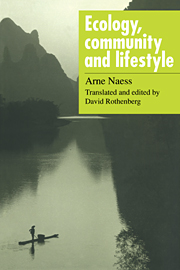Book contents
- Frontmatter
- Contents
- Translator's preface
- Introduction: Ecosophy T – from intuition to system
- 1 The environmental crisis and the deep ecological movement
- 2 From ecology to ecosophy
- 3 Fact and value; basic norms
- 4 Ecosophy, technology, and lifestyle
- 5 Economics within ecosophy
- 6 Ecopolitics within ecosophy
- 7 Ecosophy T: unity and diversity of life
- Bibliography
- Index
7 - Ecosophy T: unity and diversity of life
Published online by Cambridge University Press: 13 October 2009
- Frontmatter
- Contents
- Translator's preface
- Introduction: Ecosophy T – from intuition to system
- 1 The environmental crisis and the deep ecological movement
- 2 From ecology to ecosophy
- 3 Fact and value; basic norms
- 4 Ecosophy, technology, and lifestyle
- 5 Economics within ecosophy
- 6 Ecopolitics within ecosophy
- 7 Ecosophy T: unity and diversity of life
- Bibliography
- Index
Summary
In the face of increasing environmental problems, the solutions proposed during the late 60s and early 70s revealed two trends, one in which it was presumed that a piecemeal approach within the established economic, social, and technological framework is adequate, another which called for critical examination of the man–nature relation and basic changes which would affect every aspect of human life. The latter trend, that of the deep ecological movement, involves both concrete decisions in environmental conflicts and abstract guidelines of philosophical character. It is not a mere philosophy of man–nature.
In the previous chapters a large number of problem areas have been touched upon, primarily the technological, economic, and political. Ultimate foundations have also been considered, particularly the contrast between atomistic and gestalt thinking. It remains to go into a number of philosophical issues, and also to touch upon the religious background of man–nature thinking in the West. The treatment will have to be more personal in the sense of leading into particular aspects of my ecosophy, Ecosophy T. But it is not the aim to point to my own particular view in special detail. Much has been already said without explicitly connecting it to the Ecosophy T logical structure. The main goal, as announced in chapter 2, is to emphasise the responsibility of any integrated person to work out his or her reaction to contemporary environmental problems on the basis of a total view.
- Type
- Chapter
- Information
- Ecology, Community and LifestyleOutline of an Ecosophy, pp. 163 - 212Publisher: Cambridge University PressPrint publication year: 1989



